A Post By: Darlene Hildebrandt
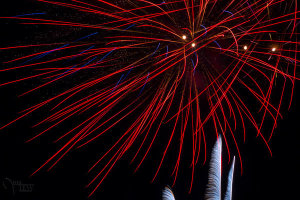 With the summer coming up and different celebrations you may have the opportunity to photograph some fireworks. If you’re in the USA you have the 4th of July, in Canada July 1st. In many other places you can find fireworks festivals or competitions even, or special occasions when fireworks may be set off including weddings, New Years Day or course and of course at Disneyland!
With the summer coming up and different celebrations you may have the opportunity to photograph some fireworks. If you’re in the USA you have the 4th of July, in Canada July 1st. In many other places you can find fireworks festivals or competitions even, or special occasions when fireworks may be set off including weddings, New Years Day or course and of course at Disneyland!
So here’s a few tips to help you photograph fireworks. The biggest thing to remember is that it’s all about practice, experimentation, and the following mantra (say it with me!)
SHOOT – REVIEW – ADJUST – REPEAT
Please remember that if you’ve never tried fireworks before it’s all trial and error and I’ve made a lot of mistakes myself before I got any images that I was happy to show anyone. Each time I photograph fireworks there’s always some element that’s unpredictable so you have to learn to adapt and learn from your own mistakes, correct for next time and do it again. So take these tips to help you get started.
15 tips for fireworks photography
#1 Use the right equipment: use a sturdy tripod and remote to fire the camera and bring an extra battery as long exposures tend to use them up quickly. I say STURDY tripod because it needs to hold your camera steady for several seconds without sinking, tipping, or wobbling. I wrote an article on my site on Tips for buying a tripod of you need more info on what to get.

This image was actually purchased by the company that put on the fireworks show in Portland.
#2 Set your ISO low like 100 or 200, for a couple reasons. First the higher the ISO you use the more noise you’ll introduce into your images, so keep it low to prevent that. Noise also lives in blue areas of images and nighttime has a lot of blue so that compounds the issue. Long exposures also tend to increase noise so if you add it all up you get a lot of noise so keep the ISO low to eliminate that variable.
#3 Turn OFF long exposure noise reduction. This setting, while it does a really good job of noise reduction, adds an extra complication you don’t need when doing photography of fireworks. The way it works is that if you take say a 10 second exposure, it takes a second one of equal length but just black (the shutter doesn’t open). Then it merges the two together and blends the blank one into the shadow areas of the first one which is where noise typically shows the most. The problem is that fireworks happen so fast you don’t want to have to wait 10 seconds to be able to see your image, make any adjustments and shoot again. I did this once my accident and it was very frustrating and I missed most of the show and did not get the results I wanted because I couldn’t review and correct.
#4 Do NOT use live view if your camera has it. This will eat up your battery really fast. Live view is really for shooting video and using the display screen so much uses a lot of power, as does making long exposures. Save your battery for actually shooting and set up your shot using the eyecup viewfinder.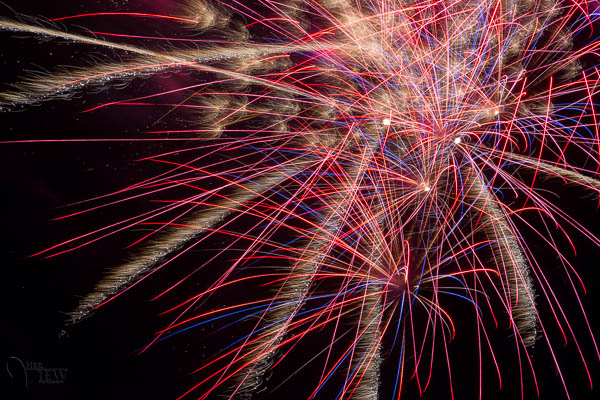
#5 set your camera on Manual mode for exposure and set your aperture to f5.6 or f8. Those apertures are pretty optimal for fireworks as the light streaks are controlled by the size of the aperture. Closing down more will make the light trails thinner, opening up more will make them wider and possible too over exposed. Do some tests but all the times I’ve done fireworks I keep coming back to f8 as my preference.
#6 Set your shutter speed to between two and ten seconds. Do a test shot before the show starts and see if the sky is too dark or too bright and adjust the exposure time accordingly. As long as you’re under 30 seconds you can let the camera time the shots for you. Or you can switch to Bulb and just open and close manually when you feel you’ve captured enough bursts in one image.
#7 Focus your lens ahead of time, and then turn off AF otherwise the camera will keep trying to refocus every shot and you may end up with missed images or blurry fireworks if the camera misses. Assuming you’re a fair distance away from the fireworks you shouldn’t have to refocus at all unless you change your angle of view or want to focus somewhere else, like the people in front of you.
#8 Use a neutral density filter to get a longer exposure if need be. If it’s not 100% dark out yet it (the sky still has some light) this will allow you to get a longer exposure and make sure the fireworks bursts have a nice arch. If your exposure is too short you’ll end up with short stubby looking bursts, not the nice umbrella shaped ones. If yours are too short, just make the exposure time longer. If you are getting too many bursts in one shot and it’s coming out over exposed, shorten the exposure time. Using the ND filter if it IS dark will also allow you to shoot longer exposures and capture more bursts per image. Play with that and try it with and without the filter if you have one. A polarizing filter will work to a lesser degree also.
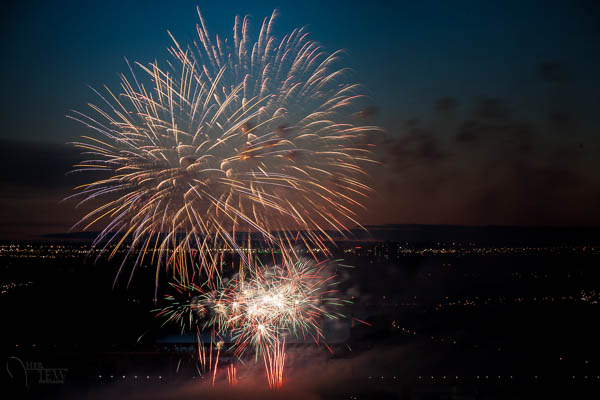
ISO 100, f/10, 1 second – notice the bursts don’t really make a nice arch? A longer exposure will make your trails longer. You choose how you want them to appear and adjust accordingly.
#9 Shoot most of your shots at the start of the show to avoid the smoke/haze that appears a bit later. Eventually the sky will be filled with smoke and it’s not as pretty looking. That’s when I’ll try some close ups or abstracts (keep reading for more on that later)
#10 Scout your location ahead of time and get there early to get a good spot, think about background (what’s behind the show) and if you want the people around and in front of you as part of the shot. In general the good viewing areas fill up sometimes 1-2 hours prior to the fireworks show. If you want a good spot with enough room for you and your tripod, go early and take a good book or something to entertain you while you wait.
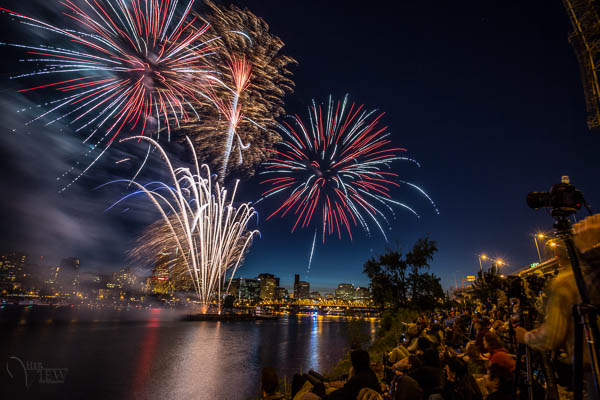
Notice I’ve included the crowd to show perspective.
#11 Make sure you leave enough room in your frame to anticipate the height of the opened bursts. Adjust as necessary if you miss on the first shot – it’s a lot of trial and error and correcting. It’s often hard to tell where the highest fireworks will end up in the sky, you may want to try both horizontal and vertical compositions.
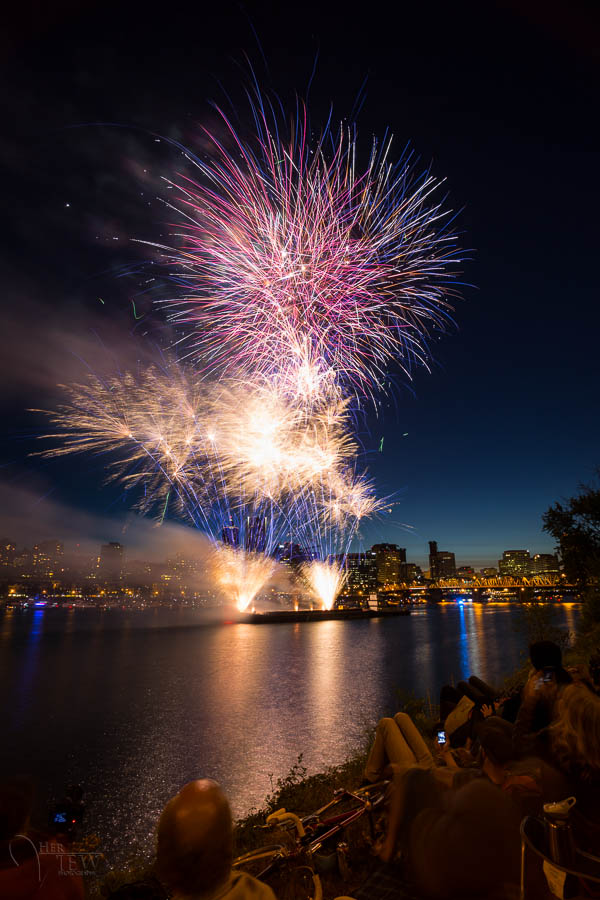
Try a vertical composition for an added sense of power, especially if you can get a reflection like this.
#12 It takes a bit of practice to time your shots when you hear the fireworks being released, so ideally you capture a few bursts. Do some testing to see how many bursts is just right for your taste. Try some with more, and some with less. Having too many may overexpose the overall image, so keep that in mind.
#13 Shoot into the eastern sky not facing west, if you want a darker sky. Here in Edmonton we are quite far north and even by 10:30pm in the summer the sky is not fully dark yet. I’ve found that when I shoot into the sunset my sky gets too blown out and the lights of the fireworks don’t show up as well as they do against a darker sky. So try and find a vantage point that has you facing east when possible if that’s an issue for you as well.
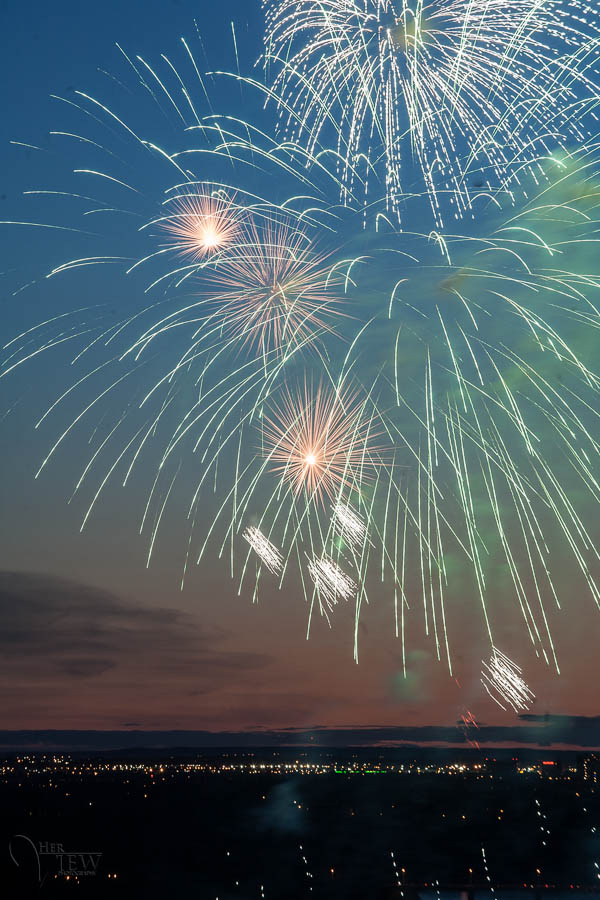
#14 Try some telephoto shots as well as the usual wide, try some close ups zoomed in tighter for something a bit more abstract. For this you will need to aim basically into thin air and try to anticipate where the bursts will open

Abstracted using a longer lens, I think they look like palm trees.
#15 if you have a zoom lens try zooming during the exposure and see what you get! If you’re going to try this make sure you have focused at the most zoomed in point of the lens. Try different technique including counting 1/2 the exposure before you zoom, or zooming right away and the last 1/2 is zoomed out. Try zooming fast, then slow. Try more bursts, or less. Get some city lights in the shot too.
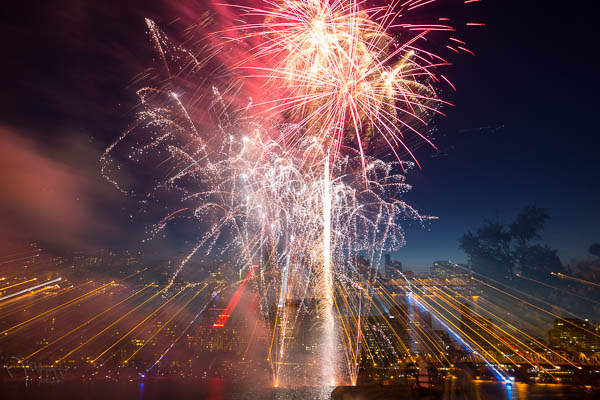
ISO 100, f/6.3, 6 seconds – lens zoomed during the exposure.
Summary
The biggest tip I can give you overal is experiment with your settings to get the look you want. Use my settings above as a starting point, adapt to your situation and your camera equipment until you’re happy with the results.
Have a great time this summer trying these out and don’t forget to share your images of fireworks, and any additional tips you’d like to add.